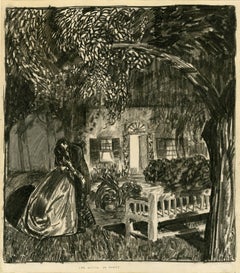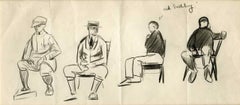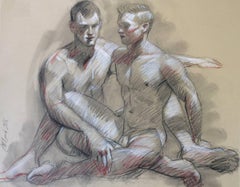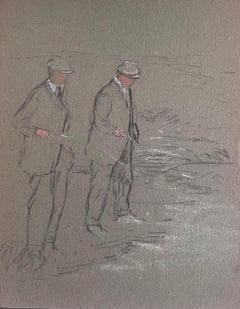George Wesley Bellows Figurative Drawings and Watercolors
American, 1882-1925
George Bellows, an American artist, was born in Columbus, Ohio in 1882, the only child of a successful building contractor from Sag Harbor, New York. He entered Ohio State University in 1901, where he played baseball and basketball and made drawings for college publications. He dropped out of college in 1904, went to New York, and studied under Robert Henri (American, 1865 – 1929) at the New York School of Art, where Edward Hopper (American, 1882 – 1967), Rockwell Kent (American, 1882 – 1971), and Guy Pène du Bois (American, 1884 – 1958) were his classmates. A superb technician who worked in a confident, painterly style, Bellows soon established himself as the most important realist of his generation. He created memorable images of club fights, street urchins swimming in the East River, and the Pennsylvania Station excavation site and garnered praise from both progressive and conservative critics.
In 1910 Bellows began teaching at the Art Students League and married Emma Story, by whom he had two daughters. After 1910 Bellows gradually abandoned the stark urban realism and dark palette characteristic of his early work and gravitated toward painting landscapes, seascapes, and portraits.
Bellows helped organize the Armory Show in 1913, in which five of his paintings and a number of drawings were included. That year he was elected a full member of the National Academy of Design. He had leftist political views and contributed illustrations to the Socialist publication The Masses from 1912 to 1917. Bellows began to make lithographs in 1916 and his exceptional talent engendered a revival of interest in the medium. He worked in Maine, in Carmel, California, and in Middletown, Rhode Island, and was a founding member of the Society of Independent Artists and a charter member of the Association of American Painters and Sculptors. In 1919 he taught at the Art Institute of Chicago.
Bellows, who never went to Europe, is regarded as a quintessential American artist whose vigorous style enabled him to explore a wide range of subjects from scenes of modern urban life to portraits of his daughters, to turbulent Maine seascapes. As an early biographer noted, Bellows “caught the brute force of the prizefighter, the ruggedness of the country pasture, the essence of childhood and recorded them appropriately not only for his own generation but for all time.”[1]
[1] [Frederick A. Sweet], George Bellows: Paintings, Drawings and Prints (Art Institute of Chicago, IL, 1946).
Robert Torchia September 29, 2016to
2
Overall Width
to
Overall Height
to
2
1
1
1
1
1
1
1
1
1
1
1
6
883
324
192
177
2
Artist: George Wesley Bellows
The Mouth of Honey
By George Wesley Bellows
Located in Fairlawn, OH
The Mouth of Honey
Lithographic crayon and mixed media on paper mounted to support paper
Initialed by the artist "GB" bottom center on image. (see photo)
Titled in pencil in bottom m...
Category
1920s Ashcan School George Wesley Bellows Figurative Drawings and Watercolors
Materials
Crayon
red ballboy or Studies for "Tennis Tournament"
By George Wesley Bellows
Located in Fairlawn, OH
Red Ballboy or Studies for "Tennis Tournament"
Crayon on paper, c. 1920
Unsigned
Condition: three vertical folds created by the artist to transport the drawing from the tennis match ...
Category
1910s Ashcan School George Wesley Bellows Figurative Drawings and Watercolors
Materials
Graphite
Related Items
MB 809 (Figurative Charcoal Drawing on Paper of Two Seated Male Nude Models)
By Mark Beard
Located in Hudson, NY
Figurative drawing made with graphite, conte crayon and charcoal on Arches paper
21.5 x 28 inches, unframed
This unique life study drawing of two seated male nude models was made ...
Category
2010s Modern George Wesley Bellows Figurative Drawings and Watercolors
Materials
Archival Paper, Charcoal, Graphite
$1,600
H 21.5 in W 28 in
British Chalk Pencil Sketch of Two Dapper Gentleman Fishing On The Riverbank
Located in Cirencester, Gloucestershire
John Rabone Harvey ( 1966 - 1922)
graphic and chalk deep green artist paper , unframed
artist paper : 7 x 5.5 inches
Provenance: private collection
Condition: very good condition
Ha...
Category
Mid-19th Century Realist George Wesley Bellows Figurative Drawings and Watercolors
Materials
Chalk, Graphite
British Chalk Pencil Sketch of a Farmer Shovelling In The Fields
Located in Cirencester, Gloucestershire
John Rabone Harvey ( 1966 - 1922)
graphic and chalk deep green artist paper , unframed
artist paper : 7 x 5.5 inches
Provenance: private collection
Condition: very good condition
Ha...
Category
Mid-19th Century Realist George Wesley Bellows Figurative Drawings and Watercolors
Materials
Chalk, Graphite
Woodland Scene, 1956 circa - Gouache and Pastel Painting, Green Trees + Leaf
By Peter Potworowski
Located in Kingsclere, GB
Peter Potworowski 1898-1962
Woodland Scene, 1956, circa
gouache and pastel
25.1 x 28.2 cm
9 7/8 x 11 1/8 in
unsigned
Tadeusz Piotr (Peter) Potworowski was a Polish abstract and figu...
Category
20th Century George Wesley Bellows Figurative Drawings and Watercolors
Materials
Pastel, Gouache
Norman Barr, Coney Island (large), 1940
By Norman Barr
Located in New York, NY
Norman Barr recorded his beloved New York City from the Bronx, to Coney Island, to the Fulton Fish Market.
In this period he was on the New Deal's Mural ...
Category
Mid-20th Century Ashcan School George Wesley Bellows Figurative Drawings and Watercolors
Materials
Crayon, India Ink
British Chalk Pencil Sketch of A Young Boy In His Fishing Gear
Located in Cirencester, Gloucestershire
John Rabone Harvey ( 1966 - 1922)
graphic and chalk deep green artist paper , unframed
artist paper : 7 x 5.5 inches
Provenance: private collection
Condition: very good condition
Ha...
Category
Mid-19th Century Realist George Wesley Bellows Figurative Drawings and Watercolors
Materials
Chalk, Graphite
Norman Barr, Delancey Street (NYC)
By Norman Barr
Located in New York, NY
Norman Barr recorded his beloved New York City from the Bronx, to Coney Island, to the Fulton Fish Market.
In this period he was on the New Deal's Mural ...
Category
Mid-20th Century Ashcan School George Wesley Bellows Figurative Drawings and Watercolors
Materials
Crayon, India Ink
A Pair of Framed Monkey Studies
By Alexander Oscar Levy
Located in Buffalo, NY
A pair of exquisite drawings by American Ashcan School artist Alexander Oscar Levy.
Category
1920s Ashcan School George Wesley Bellows Figurative Drawings and Watercolors
Materials
Archival Paper, Graphite
Paul Gattuso, (Young Woman)
By Paul Gattuso.
Located in New York, NY
Paul Gattuso attended the Art Students League and worked primarily in New York City. There is an old address with a Bronx, Grand Concourse address.
Gattus...
Category
1930s Ashcan School George Wesley Bellows Figurative Drawings and Watercolors
Materials
Monotype
"House Studies Series V", Layered Paper and Drawing Collage, Architectural
By Seth Clark
Located in Philadelphia, PA
This layered paper and drawing collage titled "House Studies Series V" is an original artwork by Seth Clark made of paper, charcoal, pastel, graphite, and acrylic on wood. Through a ...
Category
21st Century and Contemporary Contemporary George Wesley Bellows Figurative Drawings and Watercolors
Materials
Paper, Graphite, Wood, Charcoal, Pastel, Mixed Media, Acrylic
British Chalk Pencil Sketch of Two Dapper Gentleman Fishing On The Riverbank
Located in Cirencester, Gloucestershire
John Rabone Harvey ( 1966 - 1922)
graphic and chalk deep green artist paper , unframed
artist paper : 7 x 5.5 inches
Provenance: private collection
Condition: very good condition
Ha...
Category
Mid-19th Century Realist George Wesley Bellows Figurative Drawings and Watercolors
Materials
Chalk, Graphite
British Chalk Pencil Sketch of Farmers Harvesting the Fields
Located in Cirencester, Gloucestershire
John Rabone Harvey ( 1966 - 1922)
graphic and chalk deep green artist paper , unframed
artist paper : 5.5 x 7 inches
Provenance: private collection
Condition: very good condition
Ha...
Category
Mid-19th Century Realist George Wesley Bellows Figurative Drawings and Watercolors
Materials
Chalk, Graphite
George Wesley Bellows figurative drawings and watercolors for sale on 1stDibs.
Find a wide variety of authentic George Wesley Bellows figurative drawings and watercolors available for sale on 1stDibs. You can also browse by medium to find art by George Wesley Bellows in crayon, graphite, pencil and more. Not every interior allows for large George Wesley Bellows figurative drawings and watercolors, so small editions measuring 10 inches across are available. Customers who are interested in this artist might also find the work of and Norman Barr. George Wesley Bellows figurative drawings and watercolors prices can differ depending upon medium, time period and other attributes. On 1stDibs, the price for these items starts at $3,500 and tops out at $55,000, while the average work can sell for $29,250.
Questions About George Wesley Bellows Figurative Drawings and Watercolors
- 1stDibs ExpertApril 5, 2022Cliff Dwellers by George Bellows is a painting created in 1913 that’s meant to depict the explosive population growth that New York City was experiencing at the time. Specifically, the painting is of a hot summer’s day in New York City’s Lower East Side. On 1stDibs, find a variety of original artwork from top artists.
- 1stDibs ExpertApril 5, 2022George Bellows created paintings that focussed on realism. His oil paintings mixed urban studies with social and political themes, mainly centered around New York City. On 1stDibs, you can shop a selection of George Bellow’s pieces from some of the world’s top art dealers from the comfort of your home.



